Mercury Mountaineer 2007 Manual de Usuario (in Spanish)
Manufacturer: MERCURY, Model Year: 2007, Model line: Mountaineer, Model: Mercury Mountaineer 2007Pages: 48, tamaño PDF: 0.37 MB
Page 21 of 48

ARRASTRE DE REMOLQUE
Es posible que su vehÛculo est× equipado para arrastrar remolques (o es
posible que requiera un paquete de arrastre de remolques). Antes de
manejar su vehÛculo con un remolque, asegìrese de cumplir con las
instrucciones que aparecen en el ªManual de arrastre de remolques y
RVº. El peso combinado total del vehÛculo y el remolque debe ser menor
o igual al Peso bruto combinado mµximo (GCWR) recomendado y debe
estar equilibrado y asegurado en forma adecuada. Consulte el ªManual de
arrastre de remolques y RV,º el ªManual del propietarioº o consulte a un
distribuidor Ford o Lincoln/Mercury autorizado para obtener mµs
informaciân.
Arrastre de remolque
21
Page 22 of 48
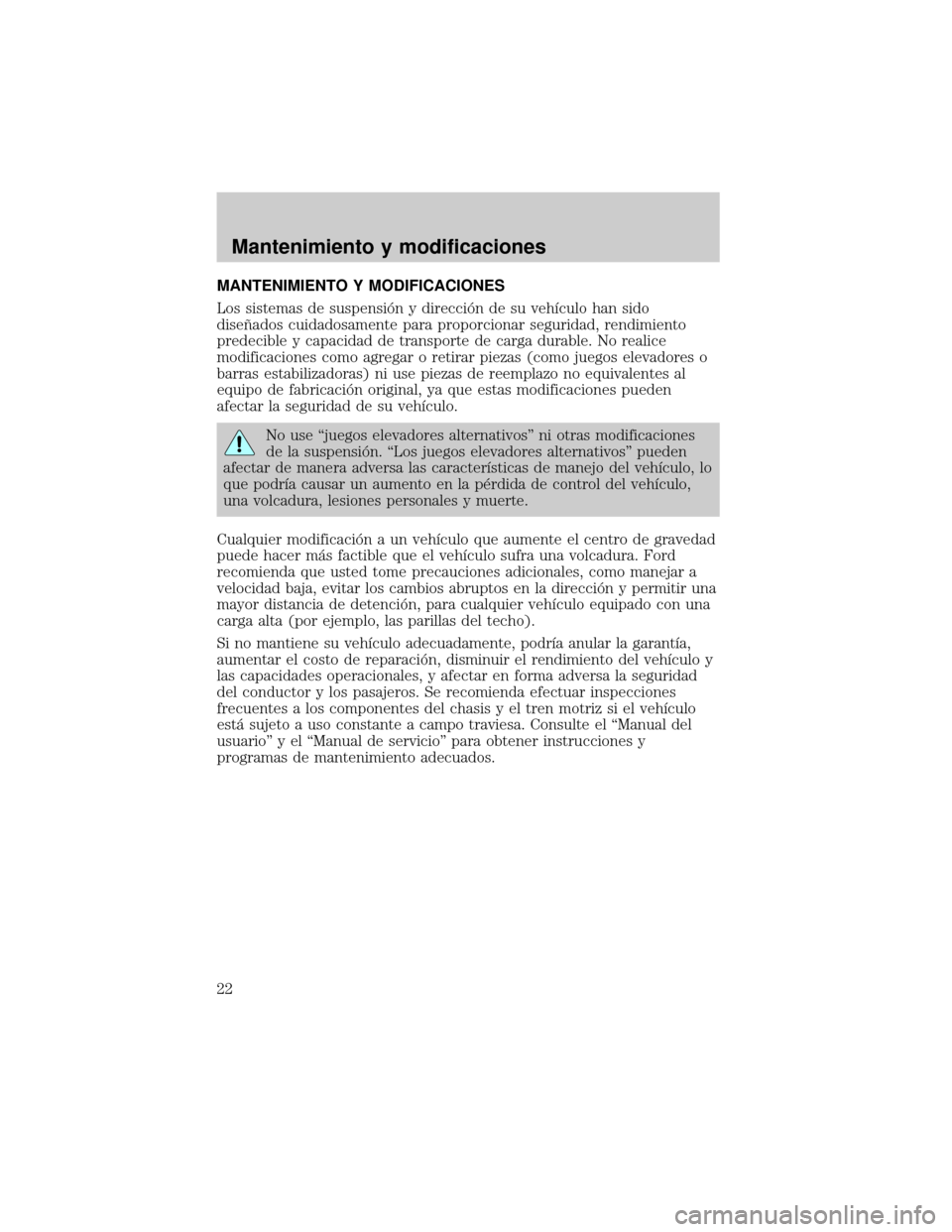
MANTENIMIENTO Y MODIFICACIONES
Los sistemas de suspensiân y direcciân de su vehÛculo han sido
diseÞados cuidadosamente para proporcionar seguridad, rendimiento
predecible y capacidad de transporte de carga durable. No realice
modificaciones como agregar o retirar piezas (como juegos elevadores o
barras estabilizadoras) ni use piezas de reemplazo no equivalentes al
equipo de fabricaciân original, ya que estas modificaciones pueden
afectar la seguridad de su vehÛculo.
No use ªjuegos elevadores alternativosº ni otras modificaciones
de la suspensiân. ªLos juegos elevadores alternativosº pueden
afectar de manera adversa las caracterÛsticas de manejo del vehÛculo, lo
que podrÛa causar un aumento en la p×rdida de control del vehÛculo,
una volcadura, lesiones personales y muerte.
Cualquier modificaciân a un vehÛculo que aumente el centro de gravedad
puede hacer mµs factible que el vehÛculo sufra una volcadura. Ford
recomienda que usted tome precauciones adicionales, como manejar a
velocidad baja, evitar los cambios abruptos en la direcciân y permitir una
mayor distancia de detenciân, para cualquier vehÛculo equipado con una
carga alta (por ejemplo, las parillas del techo).
Si no mantiene su vehÛculo adecuadamente, podrÛa anular la garantÛa,
aumentar el costo de reparaciân, disminuir el rendimiento del vehÛculo y
las capacidades operacionales, y afectar en forma adversa la seguridad
del conductor y los pasajeros. Se recomienda efectuar inspecciones
frecuentes a los componentes del chasis y el tren motriz si el vehÛculo
estµ sujeto a uso constante a campo traviesa. Consulte el ªManual del
usuarioº y el ªManual de servicioº para obtener instrucciones y
programas de mantenimiento adecuados.
Mantenimiento y modificaciones
22
Page 23 of 48

23
Page 24 of 48

24
Page 25 of 48
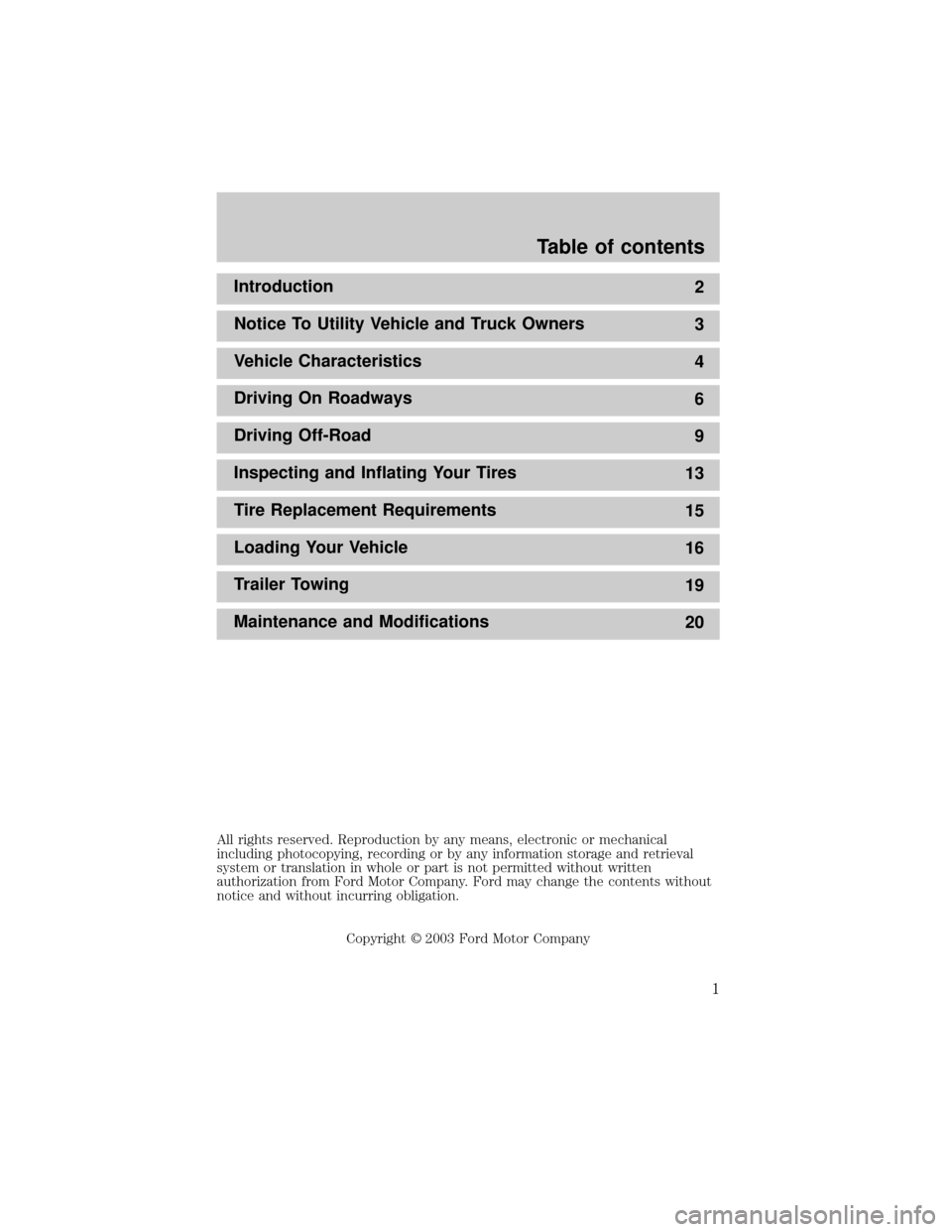
Introduction
2
Notice To Utility Vehicle and Truck Owners
3
Vehicle Characteristics
4
Driving On Roadways
6
Driving Off-Road
9
Inspecting and Inflating Your Tires
13
Tire Replacement Requirements
15
Loading Your Vehicle
16
Trailer Towing
19
Maintenance and Modifications
20
All rights reserved. Reproduction by any means, electronic or mechanical
including photocopying, recording or by any information storage and retrieval
system or translation in whole or part is not permitted without written
authorization from Ford Motor Company. Ford may change the contents without
notice and without incurring obligation.
Copyright 2003 Ford Motor Company
Table of contents
1
Page 26 of 48

INTRODUCTION
Welcome to Ford Motor Company's
world of Sport Utility Vehicles
(SUV) and truck driving! Your new
vehicle opens up a completely
different and challenging world of
travel unlike what you have ever
experienced with a conventional car. Most importantly, you'll be able to
travel with the safety, comfort and dependability of a Ford-built vehicle.
Your vehicle, particularly when loaded, will handle differently than an
ordinary passenger car. This is because your vehicle has special design
and equipment features for cargo-hauling or off-road operation.
Study this supplement and the ªOwner's Guideº for specific information
about equipment features and instructions for safe driving. You must also
learn and understand the capabilities and limitations of your vehicle
through experience. Take it slow and easy until you get to know and
understand your vehicle.
Driving at speeds safe for road conditions and the use of safety belts are
the best means of avoiding the possibility of accident and serious injury.
All occupants must wear the safety belts and children/infants must use
appropriate restraints to minimize the risk of injury or ejection.
Ford Motor Company reserves the right at any time to change
information provided herein, including specifications, design or
testing procedures without incurring obligation.
Introduction
Introduction
2
Page 27 of 48
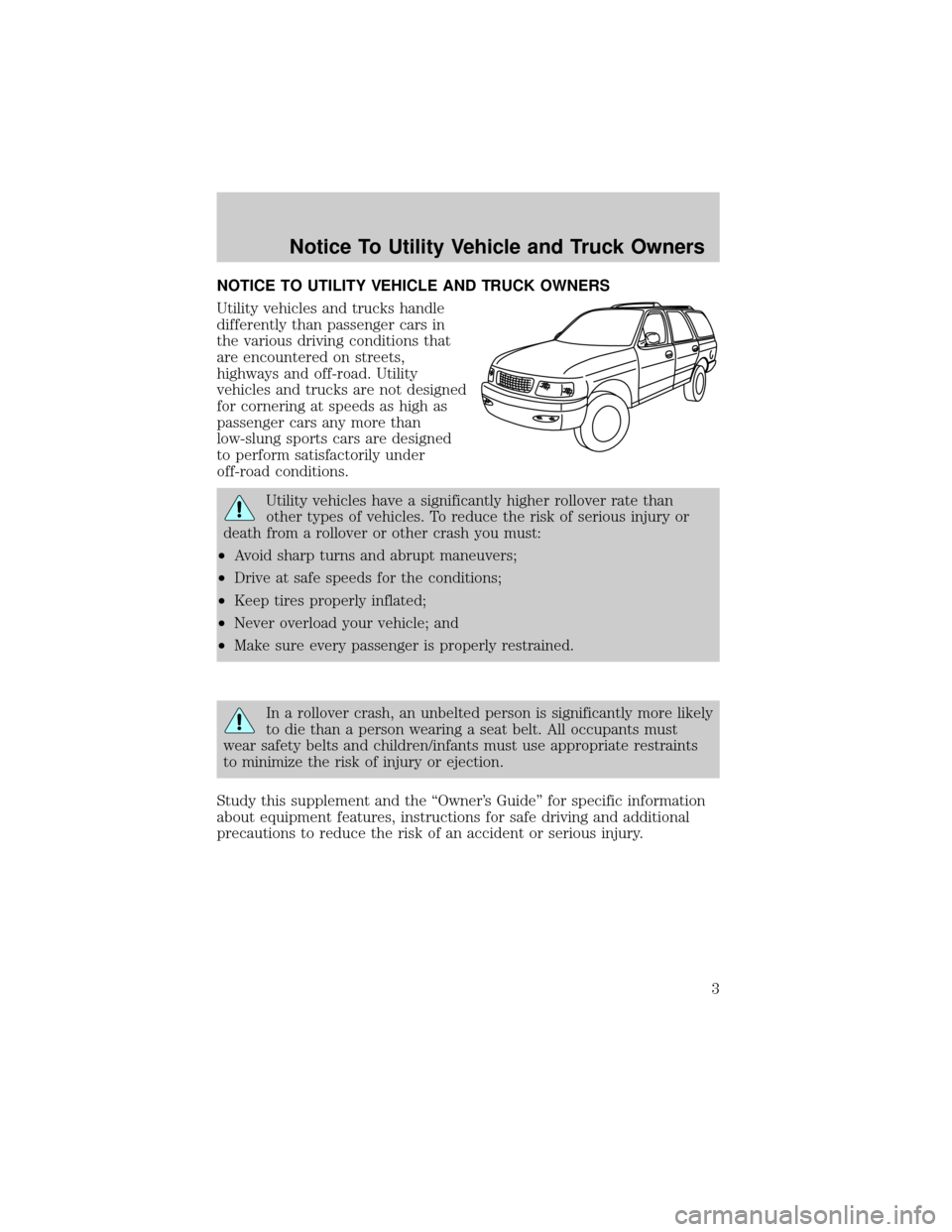
NOTICE TO UTILITY VEHICLE AND TRUCK OWNERS
Utility vehicles and trucks handle
differently than passenger cars in
the various driving conditions that
are encountered on streets,
highways and off-road. Utility
vehicles and trucks are not designed
for cornering at speeds as high as
passenger cars any more than
low-slung sports cars are designed
to perform satisfactorily under
off-road conditions.
Utility vehicles have a significantly higher rollover rate than
other types of vehicles. To reduce the risk of serious injury or
death from a rollover or other crash you must:
²Avoid sharp turns and abrupt maneuvers;
²Drive at safe speeds for the conditions;
²Keep tires properly inflated;
²Never overload your vehicle; and
²Make sure every passenger is properly restrained.
In a rollover crash, an unbelted person is significantly more likely
to die than a person wearing a seat belt. All occupants must
wear safety belts and children/infants must use appropriate restraints
to minimize the risk of injury or ejection.
Study this supplement and the ªOwner's Guideº for specific information
about equipment features, instructions for safe driving and additional
precautions to reduce the risk of an accident or serious injury.
Notice To Utility Vehicle and Truck Owners
Notice To Utility Vehicle and Truck Owners
3
Page 28 of 48
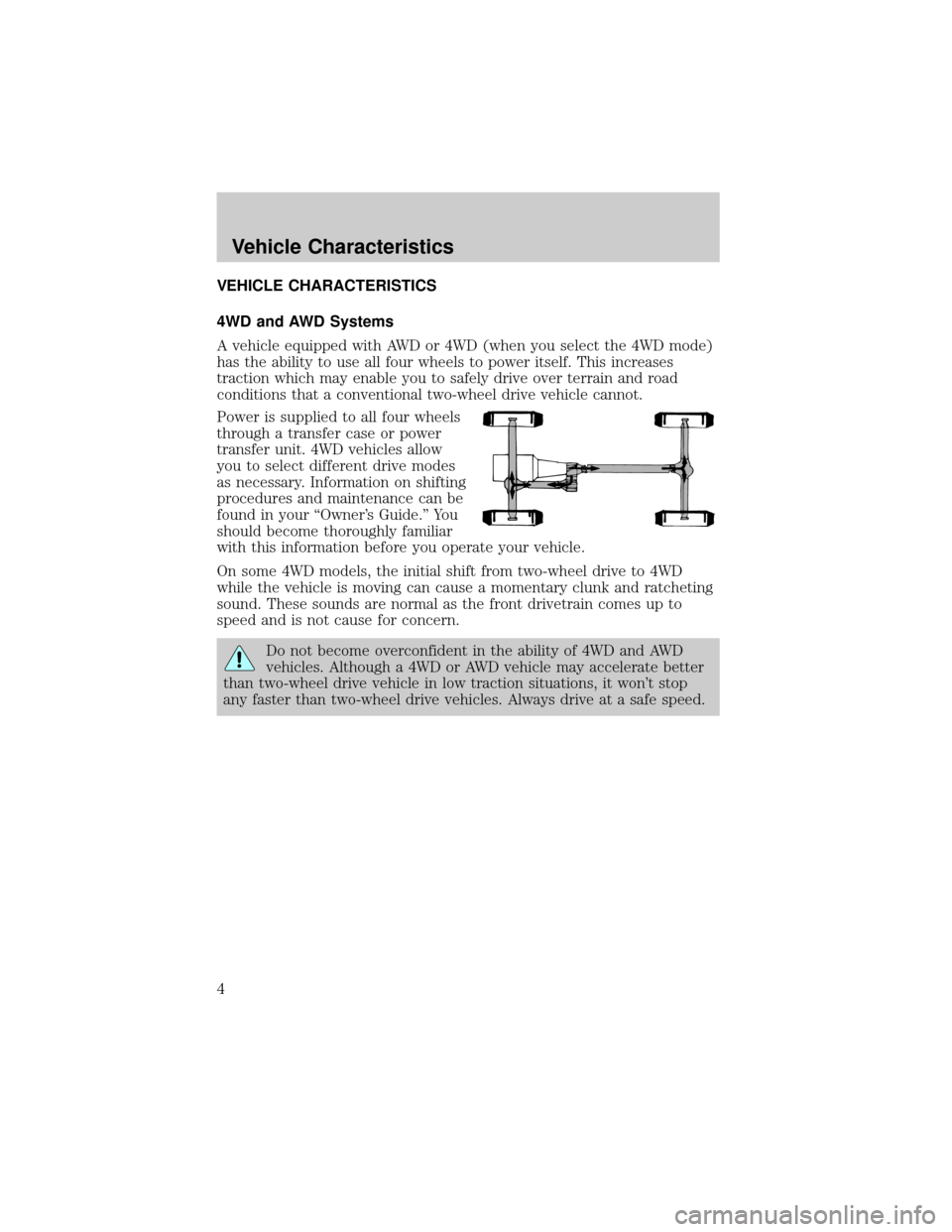
VEHICLE CHARACTERISTICS
4WD and AWD Systems
A vehicle equipped with AWD or 4WD (when you select the 4WD mode)
has the ability to use all four wheels to power itself. This increases
traction which may enable you to safely drive over terrain and road
conditions that a conventional two-wheel drive vehicle cannot.
Power is supplied to all four wheels
through a transfer case or power
transfer unit. 4WD vehicles allow
you to select different drive modes
as necessary. Information on shifting
procedures and maintenance can be
found in your ªOwner's Guide.º You
should become thoroughly familiar
with this information before you operate your vehicle.
On some 4WD models, the initial shift from two-wheel drive to 4WD
while the vehicle is moving can cause a momentary clunk and ratcheting
sound. These sounds are normal as the front drivetrain comes up to
speed and is not cause for concern.
Do not become overconfident in the ability of 4WD and AWD
vehicles. Although a 4WD or AWD vehicle may accelerate better
than two-wheel drive vehicle in low traction situations, it won't stop
any faster than two-wheel drive vehicles. Always drive at a safe speed.
Vehicle Characteristics
Vehicle Characteristics
4
Page 29 of 48
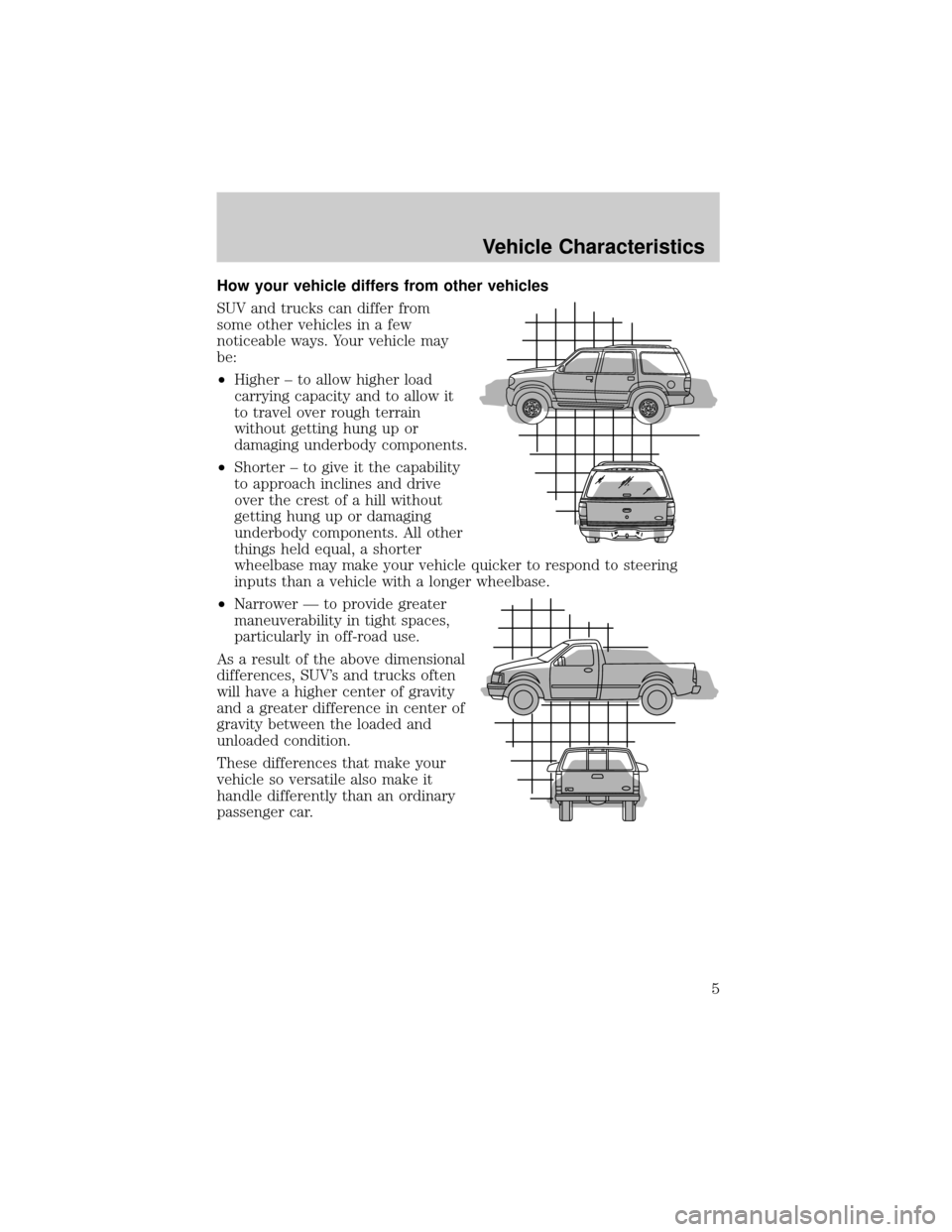
How your vehicle differs from other vehicles
SUV and trucks can differ from
some other vehicles in a few
noticeable ways. Your vehicle may
be:
²Higher ± to allow higher load
carrying capacity and to allow it
to travel over rough terrain
without getting hung up or
damaging underbody components.
²Shorter ± to give it the capability
to approach inclines and drive
over the crest of a hill without
getting hung up or damaging
underbody components. All other
things held equal, a shorter
wheelbase may make your vehicle quicker to respond to steering
inputs than a vehicle with a longer wheelbase.
²Narrower Ð to provide greater
maneuverability in tight spaces,
particularly in off-road use.
As a result of the above dimensional
differences, SUV's and trucks often
will have a higher center of gravity
and a greater difference in center of
gravity between the loaded and
unloaded condition.
These differences that make your
vehicle so versatile also make it
handle differently than an ordinary
passenger car.
Vehicle Characteristics
5
Page 30 of 48
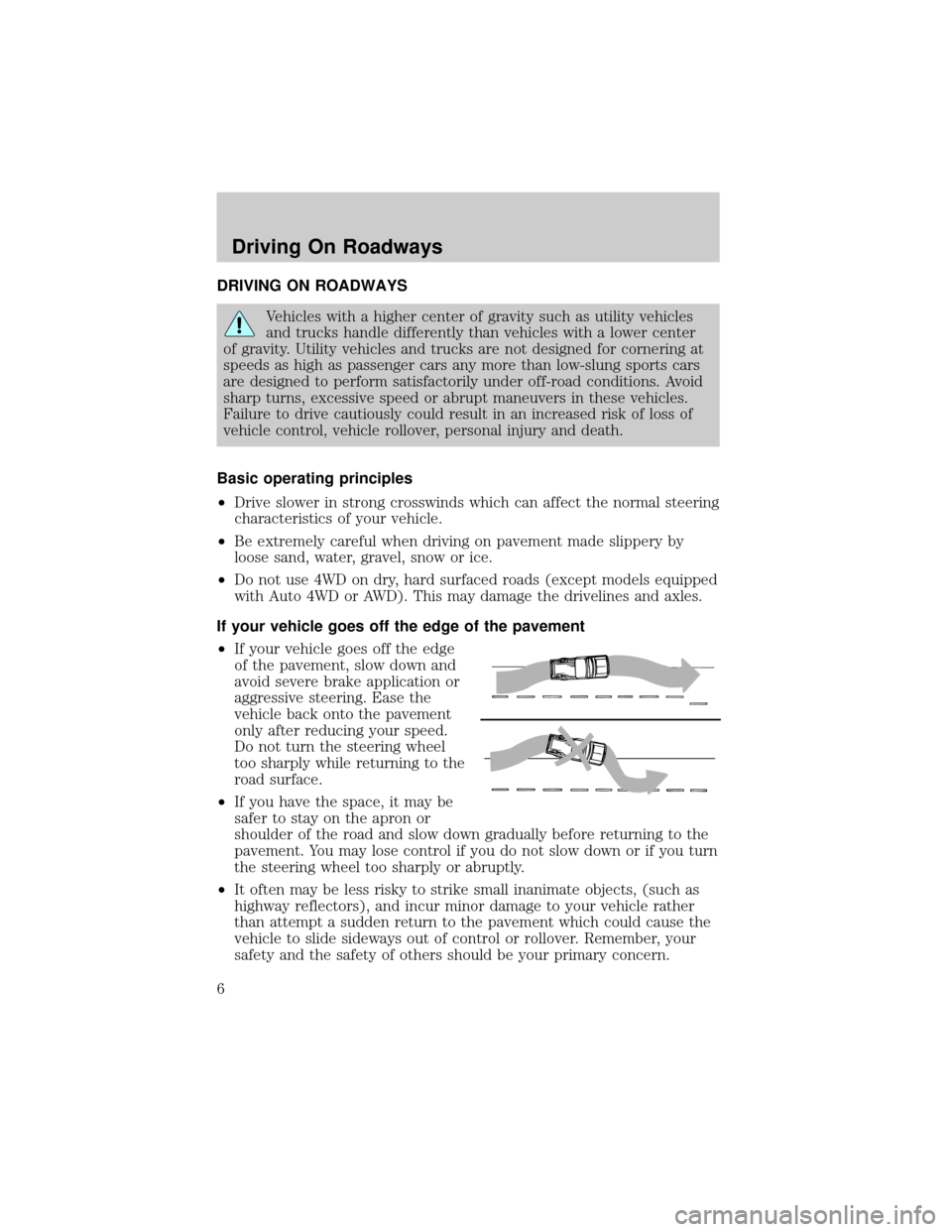
DRIVING ON ROADWAYS
Vehicles with a higher center of gravity such as utility vehicles
and trucks handle differently than vehicles with a lower center
of gravity. Utility vehicles and trucks are not designed for cornering at
speeds as high as passenger cars any more than low-slung sports cars
are designed to perform satisfactorily under off-road conditions. Avoid
sharp turns, excessive speed or abrupt maneuvers in these vehicles.
Failure to drive cautiously could result in an increased risk of loss of
vehicle control, vehicle rollover, personal injury and death.
Basic operating principles
²Drive slower in strong crosswinds which can affect the normal steering
characteristics of your vehicle.
²Be extremely careful when driving on pavement made slippery by
loose sand, water, gravel, snow or ice.
²Do not use 4WD on dry, hard surfaced roads (except models equipped
with Auto 4WD or AWD). This may damage the drivelines and axles.
If your vehicle goes off the edge of the pavement
²If your vehicle goes off the edge
of the pavement, slow down and
avoid severe brake application or
aggressive steering. Ease the
vehicle back onto the pavement
only after reducing your speed.
Do not turn the steering wheel
too sharply while returning to the
road surface.
²If you have the space, it may be
safer to stay on the apron or
shoulder of the road and slow down gradually before returning to the
pavement. You may lose control if you do not slow down or if you turn
the steering wheel too sharply or abruptly.
²It often may be less risky to strike small inanimate objects, (such as
highway reflectors), and incur minor damage to your vehicle rather
than attempt a sudden return to the pavement which could cause the
vehicle to slide sideways out of control or rollover. Remember, your
safety and the safety of others should be your primary concern.
Driving On Roadways
Driving On Roadways
6